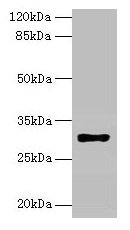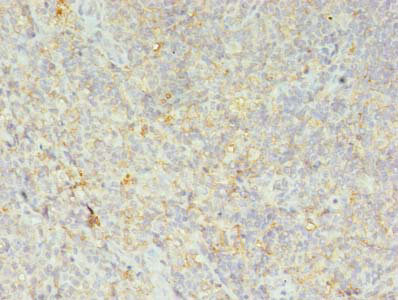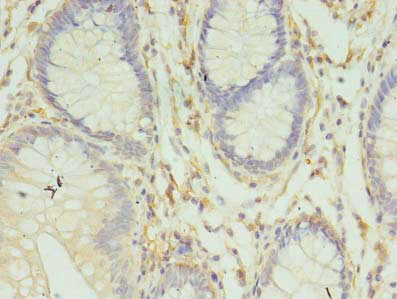HLA-DRB4 Antibody
-
货号:CSB-PA03909A0Rb
-
规格:¥440
-
促销:
-
图片:
-
Western blot
All lanes: HLA-DRB4 antibody at 2µg/ml + Raji whole cell lysate
Secondary
Goat polyclonal to rabbit IgG at 1/10000 dilution
Predicted band size: 30 kDa
Observed band size: 30 kDa -
Immunohistochemistry of paraffin-embedded human tonsil tissue using CSB-PA03909A0Rb at dilution of 1:100
-
Immunohistochemistry of paraffin-embedded human colon cancer using CSB-PA03909A0Rb at dilution of 1:100
-
-
其他:
产品详情
-
产品名称:Rabbit anti-Homo sapiens (Human) HLA-DRB4 Polyclonal antibody
-
Uniprot No.:P13762
-
基因名:
-
别名:DR 4 antibody; DR beta 4 chain antibody; DR4 antibody; DRB1 transplantation antigen antibody; DRB4 antibody; DRB4_HUMAN antibody; HLA class II histocompatibility antigen antibody; HLA class II histocompatibility antigen DR beta 4 chain antibody; HLA-DRB4 antibody; Human leucocyte antigen DRB4 antibody; Leukocyte antigen antibody; Major histocompatibility complex class II DR beta 4 antibody; MHC class II antigen DRB4 antibody; MHC class II antigen HLA DR beta antibody; MHC class2 antigen antibody; MHC HLA DR-beta chain antibody
-
宿主:Rabbit
-
反应种属:Human
-
免疫原:Recombinant Human HLA class II histocompatibility antigen, DR beta 4 chain protein (30-227AA)
-
免疫原种属:Homo sapiens (Human)
-
标记方式:Non-conjugated
本页面中的产品,HLA-DRB4 Antibody (CSB-PA03909A0Rb),的标记方式是Non-conjugated。对于HLA-DRB4 Antibody,我们还提供其他标记。见下表:
-
克隆类型:Polyclonal
-
抗体亚型:IgG
-
纯化方式:>95%, Protein G purified
-
浓度:It differs from different batches. Please contact us to confirm it.
-
保存缓冲液:Preservative: 0.03% Proclin 300
Constituents: 50% Glycerol, 0.01M PBS, PH 7.4 -
产品提供形式:Liquid
-
应用范围:ELISA, WB, IHC
-
推荐稀释比:
Application Recommended Dilution WB 1:500-1:2000 IHC 1:20-1:200 -
Protocols:
-
储存条件:Upon receipt, store at -20°C or -80°C. Avoid repeated freeze.
-
货期:Basically, we can dispatch the products out in 1-3 working days after receiving your orders. Delivery time maybe differs from different purchasing way or location, please kindly consult your local distributors for specific delivery time.
相关产品
靶点详情
-
功能:Binds peptides derived from antigens that access the endocytic route of antigen presenting cells (APC) and presents them on the cell surface for recognition by the CD4 T-cells. The peptide binding cleft accommodates peptides of 10-30 residues. The peptides presented by MHC class II molecules are generated mostly by degradation of proteins that access the endocytic route, where they are processed by lysosomal proteases and other hydrolases. Exogenous antigens that have been endocytosed by the APC are thus readily available for presentation via MHC II molecules, and for this reason this antigen presentation pathway is usually referred to as exogenous. As membrane proteins on their way to degradation in lysosomes as part of their normal turn-over are also contained in the endosomal/lysosomal compartments, exogenous antigens must compete with those derived from endogenous components. Autophagy is also a source of endogenous peptides, autophagosomes constitutively fuse with MHC class II loading compartments. In addition to APCs, other cells of the gastrointestinal tract, such as epithelial cells, express MHC class II molecules and CD74 and act as APCs, which is an unusual trait of the GI tract. To produce a MHC class II molecule that presents an antigen, three MHC class II molecules (heterodimers of an alpha and a beta chain) associate with a CD74 trimer in the ER to form a heterononamer. Soon after the entry of this complex into the endosomal/lysosomal system where antigen processing occurs, CD74 undergoes a sequential degradation by various proteases, including CTSS and CTSL, leaving a small fragment termed CLIP (class-II-associated invariant chain peptide). The removal of CLIP is facilitated by HLA-DM via direct binding to the alpha-beta-CLIP complex so that CLIP is released. HLA-DM stabilizes MHC class II molecules until primary high affinity antigenic peptides are bound. The MHC II molecule bound to a peptide is then transported to the cell membrane surface. In B-cells, the interaction between HLA-DM and MHC class II molecules is regulated by HLA-DO. Primary dendritic cells (DCs) also to express HLA-DO. Lysosomal microenvironment has been implicated in the regulation of antigen loading into MHC II molecules, increased acidification produces increased proteolysis and efficient peptide loading.
-
基因功能参考文献:
- We developed an human cardiac alpha-myosin -induced myocarditis model in human HLA-DR4 transgenic mice that lack all mouse MHCII genes. PMID: 28431892
- Strong association of nontumor anti-LGI1 encephalitis with HLA-DRB4. PMID: 28026046
- HLA-DR4 is a susceptibility factor for the development of AIH. Impaired suppressive function of Tregs and reduced PD-1 expression may result in spontaneous activation of key immune cell subsets, such as antigen-presenting cells and CD8(+) T effectors, facilitating the induction of AIH and persistent liver damage. PMID: 27414259
- HLA-DRB4 affects type 1 diabetes risk and islet autoantibodies. PMID: 26740600
- The study identifies a region of focus for B and T cell responses to IA-2 in HLA-DR4 diabetic patients that may explain HLA associations of IA-2 autoantibodies. PMID: 25225671
- HLA-DR4 codes for susceptibility to RF+ polyarticular JIA with a six-fold risk. PMID: 24618287
- The HLA- DR4 gene was clearly associated with susceptibility to rheumatoid arthritis. PMID: 23537298
- Data indicate that invariant NKT (iNKT) cell-mediated cytokine secretion in staphylococcal enterotoxin B (SEB)-challenged HLA-DR4-transgenic mice was CD1d-independent. PMID: 22041925
- Elevated frequencies of HLA-DR4 and HLA-DR5 alleles were found in patients with idiopathic dilated cardiomyopathy compared with controls. PMID: 21556773
- DRB4*01:08 is a novel HLA-DRB4 allele PMID: 21410658
- HLA-DR14/DR7/DQ5 alleles significantly increase the risk for toxic shock syndrome, regardless of individual variations in T cell receptor variable region repertoires. PMID: 21282506
- IA2 positivity was associated with HLA-DR4/X and HLA-DR3/4 positivity, and hypothyroidism was linked to HLA-DR4/4. More females carried the HLA-DR4/4 genotype or were thyroid antibody positive. PMID: 20371654
- Our results revealed HLA-DRB1*04 as predisposing factor in papillary thyroid carcinoma in Iranian population. PMID: 20164547
- Complete coding sequence of the HLA alleles DRB4*0103101 and DRB4*01033 PMID: 11972878
- DRB4 was increased in males with childhood ALL compared to age- and sex-matched controls) and female patients. HLA-DRB4 is over-represented in high-risk patients. The HLA system may be a component of genetic leukemia susceptibility in male children only. PMID: 12008082
- Comparison of HLA-DR4-associated peptides in neuroendocrine cells with those identified in lymphoblastoid B cells (LCLs) suggests that intracellular pathways allowing HLA-DR endogenous peptide processing are more efficient in endocrine cells than in LCLs. PMID: 12391221
- A novel allele of HLA-DRB4 was found. PMID: 12859598
- differential expression of genes encoded within the RA-associated HLA-DR4 superhaplotype and within the neutral DR7 and DR9 superhaplotypes. PMID: 14558083
- In patients with autoimmune thyroiditis the HLA-DR11 frequency was higher than control values, while in patients with autoimmune polyglandular syndrome type II, the HLA-DR3 frequency was found to be higher. PMID: 15046556
- Interaction between the HLA-DRB4 and CTLA-4 genes determines the thyroid function of TPO-positive goitrous Japanese Hashimoto's thyroiditis patients. PMID: 15055474
- No definite association was found between HLA-DR alleles and the risk of psoriasis or psoriatic arthritis. PMID: 15513680
- HIP is an islet protein naturally processed and presented by HLA-DR4 molecules PMID: 15721314
- Genetic variation associated with type 1 diabetes in a Czech Republic population with childhood onset. PMID: 16629714
- a diabetic intrauterine environment interacts with gene(s) marked by the type 1 diabetes susceptibility HLA DR4 alleles to increase fetal growth PMID: 17310371
- The shared epitope assessed on all HLA-DRB1 serotypic backgrounds except DR1 was associated with RA susceptibility. The presence of the shared epitope on DR4 is associated with greater RA susceptibility and certain disease-activity measures. PMID: 17491100
- findings indicate that HLA-DRB4 is a genetic risk factor for the development of Churg-Strauss syndrome and increases the likelihood of development of vasculitic manifestations of the disease. PMID: 17763415
- DRB1*04 may be a protective factor in paucibacillary leprosy. PMID: 18053473
- A model of mixed connective tissue disease has been developed in mice that express the transgene HLA-DRA*0101/DRB1*0401 in a fusion protein with U1-70-kDa ribonucleoprotein autoantigen. PMID: 18523312
- Thirty-eight percent of the B burgdorferi-infected DR4+/+CD28(-/-)MHCII(-/-) mice, but none of the B burgdorferi-infected CD28(-/-)MHCII(-/-) mice, remained arthritic post-antibiotic treatment PMID: 19035513
- associated with antiphospholipid syndrome PMID: 19052923
- Significant transmission disequilibrium for HLA-DR4 was seen (odds ratio, 4.67; 95% confidence interval, 1.34-16.24; P = .008) for transmissions from maternal grandparents to mothers of probands. PMID: 19487610
显示更多
收起更多
-
亚细胞定位:Cell membrane; Single-pass type I membrane protein. Endoplasmic reticulum membrane; Single-pass type I membrane protein. Golgi apparatus, trans-Golgi network membrane; Single-pass type I membrane protein. Endosome membrane; Single-pass type I membrane protein. Lysosome membrane; Single-pass type I membrane protein. Late endosome membrane; Single-pass type I membrane protein. Note=The MHC class II complex transits through a number of intracellular compartments in the endocytic pathway until it reaches the cell membrane for antigen presentation.
-
蛋白家族:MHC class II family
-
数据库链接:
HGNC: 4952
KEGG: hsa:3126
UniGene: Hs.534322
Most popular with customers
-
-
YWHAB Recombinant Monoclonal Antibody
Applications: ELISA, WB, IF, FC
Species Reactivity: Human, Mouse, Rat
-
Phospho-YAP1 (S127) Recombinant Monoclonal Antibody
Applications: ELISA, WB, IHC
Species Reactivity: Human
-
-
-
-
-
























